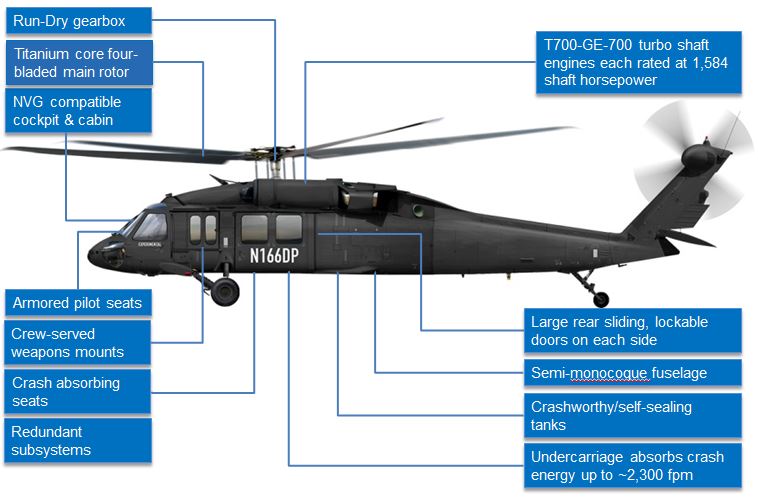Unlocking Peak Performance: UH 60 Helicopter Upkeep Guide
Unlocking Peak Performance: UH 60 Helicopter Upkeep Guide
Blog Article
Understanding the Mechanics and Engineering Behind Uh 60 Helicopters
The UH-60 helicopter, commonly known as the Black Hawk, stands as a peak of modern rotorcraft innovation, embodying a blend of durable design and elaborate technicians. From its inception to its present models, the evolution of this airplane showcases a combination of technology and practicality. As we peel off back the layers of the UH-60's layout, a globe of detailed systems and thorough design emerges. Comprehending the mechanics and engineering behind this versatile airplane unveils a world where precision meets power, and where each part plays a critical role in attaining trip.
History of UH-60 Helicopters
The background of UH-60 helicopters traces back to the late 1970s when the USA Army sought a sophisticated and versatile energy helicopter to change its aging fleet. In reaction to this need, the Sikorsky Airplane Firm created the UH-60 Black Hawk helicopter. Presented in 1979, the UH-60 swiftly came to be a staple in army procedures because of its impressive capabilities.
The UH-60 was made to succeed in a selection of objectives, consisting of army transport, clinical evacuation, digital warfare, and unique operations. Its ability to adjust to different duties made it an important asset to the united state Army and various other military pressures all over the world
Over the years, the UH-60 system has undertaken a number of upgrades and variants to improve its efficiency and equal advancing mission demands. These helicopters have actually seen considerable solution in problems such as the Gulf Battle, Afghanistan, and Iraq, showcasing their reliability and flexibility in varied functional environments. The UH-60's rich background is a testament to its enduring legacy as a top utility helicopter.

Engine and Power Solutions
Utilizing advanced propulsion technology, UH-60 helicopters are equipped with innovative engine and power systems to make certain ideal performance and reliability in a variety of functional situations. The UH-60, typically called the Black Hawk, is powered by 2 General Electric T700-GE-701D engines, each efficient in providing up to 1,940 shaft horsepower. These turboshaft engines give the essential thrust for the helicopter to accomplish its missions effectively, consisting of army transportation, medical evacuation, and fight assistance.

Blades System and The Rules Of Aerodynamics
Just how do the rotor system and aerodynamics of UH-60 helicopters add to their operational performance and flight capacities? The rotor system of the UH-60 helicopter plays a vital duty in providing lift and propulsion.
The rules of aerodynamics likewise play a crucial function in the efficiency of UH-60 helicopters. The streamlined body click here for more info and blades blade design reduce drag, enabling the helicopter to achieve greater speeds and better gas efficiency. The wind resistant style of the UH-60 also contributes to its capacity to operate in diverse ecological conditions, consisting of high altitudes and warm temperatures.
Avionics and Flight Control Systems

In its detailed sychronisation with the blades system and aerodynamics of UH-60 helicopters, the avionics and flight control systems create an important network of modern technologies shaping the aircraft's operational capacities. In the UH-60, these systems consist of electronic displays, communication radios, General practitioner navigating, weather radar, and autopilot systems.
The flight control systems of the UH-60 are in charge of converting the pilot's inputs right into the suitable modifications to the rotor system, ensuring stable flight and maneuverability. These systems consist of hydraulic actuators, servos, and computers that collaborate to regulate the primary and tail rotors, as well as various other flight control surfaces. By specifically handling the helicopter's flight characteristics, these systems enable pilots to perform a variety of objectives, from transportation and search-and-rescue to combat operations, with accuracy and confidence.
Function and Applications in Aviation
Avionics systems in UH-60 helicopters encompass a variety of digital systems sites that help in navigation, interaction, tracking, and regulating various airplane features. These systems include digital display screens, autopilot systems, communication radios, General practitioner navigation devices, and climate radar. Additionally, these systems integrate safety and security features such as autopilot settings, surface awareness alerting systems, and security augmentation systems to improve the total safety and functional capacities of the UH-60 helicopters in different goals, including troop transportation, medical emptying, search and rescue, and airborne firefighting.
Conclusion
In final thought, the UH-60 helicopter is a flexible airplane with an abundant history our website and advanced engineering. Its engine and power systems, rotor system, the rules of aerodynamics, avionics, and trip control systems all function with each other to make it a reliable and efficient machine.
In its elaborate sychronisation with the blades system and the rules of aerodynamics of UH-60 helicopters, the avionics and trip control systems create an important network of innovations forming the aircraft's operational capabilities.The trip control systems of the UH-60 are liable for converting the pilot's inputs right into the suitable modifications to the rotor system, making certain stable flight and ability to move. Avionics systems in UH-60 helicopters encompass an array of electronic systems that aid in navigating, interaction, monitoring, and managing various airplane features. Furthermore, these systems incorporate safety and security functions such as autopilot modes, surface understanding alerting systems, and security augmentation systems to boost the general safety and functional abilities of the UH-60 helicopters in various goals, including army transport, clinical emptying, search and rescue, and airborne firefighting.
Its engine and power systems, rotor system, aerodynamics, avionics, and trip control systems all work with each other to make it a trusted and effective machine.
Report this page